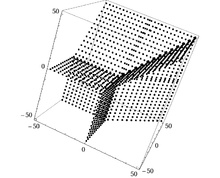Amoeba (mathematics)

P(z,w)=w-2z-1.


P(z, w) = 1 + z+z2 + z3 + z2w3 + 10zw + 12z2w +10z2w2.

P(z, w)=50 z3 +83 z2 w+24 z w2 +w3+392 z2 +414 z w+50 w2 -28 z +59 w-100.

P(x,y,z)=x+y+z-1. Note that the amoeba is actually 3-dimensional, and not a surface, (this is not entirely evident from the image).
In complex analysis, a branch of mathematics, an amoeba is a set associated with a polynomial in one or more complex variables. Amoebas have applications in algebraic geometry, espcially tropical geometry.
Definition
Consider the function
defined on the set of all n-tuples  of non-zero complex numbers with values in the Euclidean space
of non-zero complex numbers with values in the Euclidean space  given by the formula
given by the formula
Here, 'log' denotes the natural logarithm. If p(z) is a polynomial in  complex variables, its amoeba
complex variables, its amoeba  is defined as the image of the set of zeros of p under Log, so
is defined as the image of the set of zeros of p under Log, so
Amoebas were introduced in 1994 in a book by Gelfand, Kapranov, and Zelevinsky.[1]
Properties
- Any amoeba is a closed set.
- Any connected component of the complement
 is convex.[2]
is convex.[2] - The area of an amoeba of a not identically zero polynomial in two complex variables is finite.
- A two-dimensional amoeba has a number of "tentacles" which are infinitely long and exponentially narrow towards infinity.
Ronkin function
A useful tool in studying amoebas is the Ronkin function. For p(z) a polynomial in n complex variables, one defines the Ronkin function
by the formula
where  denotes
denotes  Equivalently,
Equivalently,  is given by the integral
is given by the integral
where
The Ronkin function is convex, and it is affine on each connected component of the complement of the amoeba of  .[3]
.[3]
As an example, the Ronkin function of a monomial
with  is
is
References
- ↑ Gelfand, I. M.; Kapranov, M.M.; Zelevinsky, A.V. (1994). Discriminants, resultants, and multidimensional determinants. Mathematics: Theory & Applications. Boston, MA: Birkhäuser. ISBN 0-8176-3660-9. Zbl 0827.14036.
- ↑ Itenberg et al (2007) p.3
- ↑ Gross, Mark (2004). "Amoebas of complex curves and tropical curves". In Guest, Martin. UK-Japan winter school 2004—Geometry and analysis towards quantum theory. Lecture notes from the school, University of Durham, Durham, UK, January 6–9, 2004. Seminar on Mathematical Sciences 30. Yokohama: Keio University, Department of Mathematics. pp. 24–36. Zbl 1083.14061.
- Itenberg, Ilia; Mikhalkin, Grigory; Shustin, Eugenii (2007). Tropical algebraic geometry. Oberwolfach Seminars 35. Basel: Birkhäuser. ISBN 978-3-7643-8309-1. Zbl 1162.14300.
- Viro, Oleg (2002), "What Is . . . An Amoeba?", Notices of the American Mathematical Society 49 (8): 916–917
Further reading
- Theobald, Thorsten (2002). "Computing amoebas". Exp. Math. 11 (4): 513–526. doi:10.1080/10586458.2002.10504703. Zbl 1100.14048.
External links
| Wikimedia Commons has media related to Amoeba (mathematics). |





![N_p(x)=\frac{1}{(2\pi)^n}\int_{[0, 2\pi]^n}\log|p(z)| \,d\theta_1\,d\theta_2 \cdots d\theta_n,](../I/m/488232104aa9062f43317025dbf3a4a9.png)


